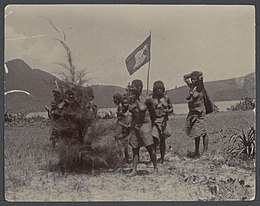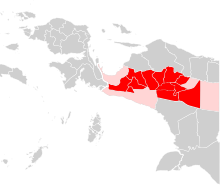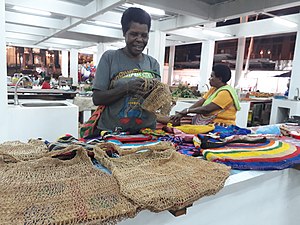
The Free Papua Movement or Free Papua Organization is a name given to independence movement based on Western New Guinea, seeking the secession of the territory currently administered by Indonesia as the provinces of Central Papua, Highland Papua, Papua, South Papua, Southwest Papua, and West Papua, also formerly known as Papua, Irian Jaya and West Irian.

The culture of Indonesia has been shaped by long interaction between original indigenous customs and multiple foreign influences. Indonesia is centrally-located along ancient trading routes between the Far East, South Asia and the Middle East, resulting in many cultural practices being strongly influenced by a multitude of religions, including Buddhism, Christianity, Confucianism, Hinduism, and Islam, all strong in the major trading cities. The result is a complex cultural mixture, often different from the original indigenous cultures.
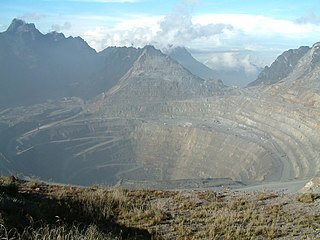
The Grasberg mine has one of the largest reserves of gold and copper in the world. It is located in Mimika Regency, Central Papua, Indonesia near Puncak Jaya. It is operated by PT Freeport Indonesia, a joint venture between the government of Indonesia, government of Papua, and American company Freeport-McMoRan (FCX).
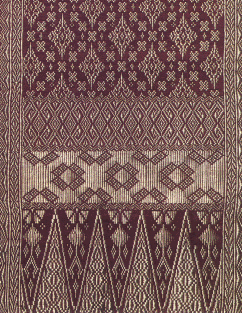
Songket or sungkit is a tenun fabric that belongs to the brocade family of textiles of Brunei, Indonesia, Malaysia, and Singapore. It is hand-woven in silk or cotton, and intricately patterned with gold or silver threads. The metallic threads stand out against the background cloth to create a shimmering effect. In the weaving process the metallic threads are inserted in between the silk or cotton weft (latitudinal) threads in a technique called supplementary weft weaving technique.

A Turkmen rug is a type of handmade floor-covering textile traditionally originating in Central Asia. It is useful to distinguish between the original Turkmen tribal rugs and the rugs produced in large numbers for export mainly in Pakistan and Iran today. The original Turkmen rugs were produced by the Turkmen tribes who are the main ethnic group in Turkmenistan and are also found in Afghanistan and Iran. They are used for various purposes, including tent rugs, door hangings and bags of various sizes.

The National Intangible Cultural Heritage of Indonesia is a "living culture" that contains philosophical elements from the traditions of society and is still handed down from generation to generation. Edi Sedyawati added an important element in the notion of intangible cultural heritage is the nature of culture that cannot be held (abstract), such as concepts and technology, its nature can pass and disappear in time with the times such as language, music, dance, ceremony, and various other structured behaviors. Thus, cultural heritage is shared by a community or community and experiences development from generation to generation, in the flow of a tradition. The Ministry of Education and Culture of Indonesia records and establishes a list of intangible cultural heritage. As of June 2020, a total of 9,770 cultural heritages have been recorded and 1,086 of them have been designated.
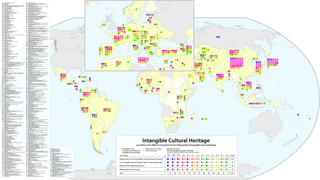
UNESCO established its Lists of Intangible Cultural Heritage with the aim of ensuring better protection of important intangible cultural heritages worldwide and the awareness of their significance. This list is published by the Intergovernmental Committee for the Safeguarding of Intangible Cultural Heritage, the members of which are elected by State Parties meeting in a General Assembly. Through a compendium of the different oral and intangible treasures of humankind worldwide, the programme aims to draw attention to the importance of safeguarding intangible heritage, which UNESCO has identified as an essential component and as a repository of cultural diversity and of creative expression.
Buchtar Tabuni is a Papuan independence activist, Chairman of the National Parliament of West Papua (PNWP), incorporating the National Committee for West Papua, and United Liberation Movement for West Papua (ULMWP) representative.
Obin, real name Josephine Komara, is a textile designer from Indonesia. She is sometimes called a "national treasure" due to her passion for and promotion of traditional Indonesian batik techniques. Her work has achieved worldwide recognition, with fellow Indonesian designers such as Edward Hutabarat and Ghea Panggabean describing her as the real authority and leader of the mid-2000s movement to update and modernise batik. Despite this, Obin describes herself as simply a tukang kain, or vendor of cloth, stating that the genuine artists and designers are the craftsmen who make the textiles retailed through Bin House, her business.

The national costume of Indonesia is the national attire that represents the Republic of Indonesia. It is derived from Indonesian culture and Indonesian traditional textile traditions. Today the most widely recognized Indonesian national attires include batik and kebaya, although originally those attires mainly belong within the island of Java and Bali, most prominently within Javanese, Sundanese and Balinese culture. Since Java has been the political and population center of Indonesia, folk attire from the island has become elevated into national status.

Mako Tabuni was a Papua New Guinea activist for Papuan interests, and the deputy chairman of the National Committee for West Papua.
Yusak Pakage is an Indonesian activist for Papuan independence, best known for his 2005–2010 imprisonment for raising the pro-independence Morning Star flag.
Al Sadu, or simply Sadu, describes an embroidery form in geometrical shapes hand-woven by Bedouin people. Sadu House in Kuwait was established by the Al Sadu Society in 1980 to protect the interests of the Bedouins and Sadu weaving.

It is quite difficult to define Indonesian art, since the country is immensely diverse. The sprawling archipelago nation consists of 17.000 islands. Around 922 of those permanently inhabited, by over 1,300 ethnic groups, which speak more than 700 living languages.
The Trans-Papua Highway refers to 12 road segments, some under construction, across Western New Guinea in Indonesia, located in the island of New Guinea. The roads stretch from Sorong to Merauke with a total length of 4,325 km (2,687 mi). As of March 2017, 3,850 km (2,390 mi) of roads had been completed and construction on all the roads was predicted to finish in 2018, but construction was delayed in late 2018 due to armed conflict.

The 2018 Papua gubernatorial election took place in Papua, Indonesia on 27 June 2018 as part of the simultaneous local elections. It was held to elect the governor of Papua along with their deputy, whilst members of the provincial council will be re-elected in 2019.

Yohana Susana Yembise is an Indonesian academician and politician who served as Indonesia's Minister of Women's Empowerment and Child Protection in Joko Widodo's Working Cabinet.
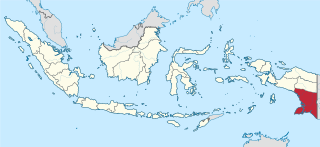
South Papua, officially the South Papua Province, is an Indonesian province located in the southern portion of Papua, following the borders of the Papuan customary region of Anim Ha. Formally established on 11 November 2022 and including the four most southern regencies that were previously part of the province of Papua and before 11 December 2002 comprised a larger Merauke Regency, it covers an area of 117,849.16 km2, and it had a population of 522,215 according to the official estimates for mid-2022, making it the least populous province in Indonesia.

Soedarmo is an Indonesian military officer and bureaucrat who was the Director General of Politics and General Government from 2015 to 2019. Due to his office in the Ministry of Home Affairs, he held acting governorships in Aceh and Papua.

Highland Papua is a province of Indonesia, which roughly follows the borders of Papuan customary region of Lano-Pago, shortened to La Pago. It covers an area of 51,213.34 km2 (19,773.58 sq mi) and had a population of 1,430,459 according to the official estimates as at mid 2022.

